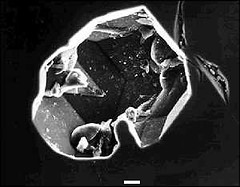
May 20, 2000 - BBC
The deepest rocks ever seen have been recovered by Australian and American researchers.
They were found at the Earth's surface on the island of Malaita, east of Papua New Guinea. But they originate from deep within the planet, between 400km and 670km down. This is about twice as deep as anything studied before.
These depths are an important region of the planet's interior, where sudden changes in the densities of rocks occur.
The discovery should reveal new information about the chemistry and large-scale movement of material passing through this transition zone between what is known as the upper and lower mantle.
At the moment, our picture of what the planet is like at these depths has been built up from studying the powerful waves of energy released by earthquakes. Tiny mineral inclusions found in diamonds and laboratory simulations have also helped construct geologists' models.
But Professor Ken Collerson, from Queensland University, who led the Malaita research, says the new rocks will greatly refine the detail.
"It's a terrific opportunity for people interested in the physical properties of rocks to establish that information for these depths," he told BBC News Online.
"It's a bit like the Hubble Space Telescope when it was out of focus. We now have a means of getting a much clearer image of the tomography of the lower mantle because we'll have physical properties to put in our equations."
Professor Collerson, and colleagues, report their work in the journal Science. They describe the Malaita specimens as being mostly made of the mineral garnet. In particular, they contain majorite, a silica-rich form of the mineral that only forms under extreme pressures.
Micro-diamonds
The team used this information to work out the sorts of pressures the rock must have experienced. They calculated pressures of up to 22 or 23 gigapascals.
"This is a huge pressure. It's equivalent to about 250,000 times atmospheric pressure at the surface of the Earth."
In addition to majorite, some of the deep mantle samples also contain micro-diamond.
The rocks would have exploded up through the Earth via deep volcanic pipes. Although this is thought to have happened on Malaita 34 million years ago, the journey itself could have taken just a few days.
"These pipes are similar to the kimberlite pipes of South Africa and elsewhere which commonly carry diamonds originating from depths of more than 150kms to the surface," Professor Collerson said.
Further detailed study of the crystal structure of the unique minerals is to be carried out with a number of international collaborators and with members of the university's Centre for Microscopy and Microanalysis over the next year.
Geology News: URL: http://www.crystalinks.com/geologynews.html